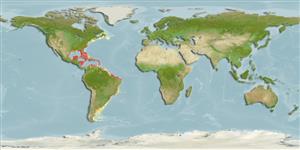Common names from other countries
Classification / Names / Names
Common names | Synonyms | Catalog of Fishes (gen., sp.) | ITIS | CoL | WoRMS
Environment: milieu / climate zone / depth range / distribution range
Ecology
Sessile; brackish; depth range 0 - 45 m (Ref. 83917). Subtropical
Western Atlantic. Subtropical and tropical.
Length at first maturity / Size / Weight / Age
Maturity: Lm ? range ? - ? cm
Colonies for thin, upright blades or plates that are somewhat branched (Ref. 415).
In shallow reef habitats with surge or more flow that A. alcicornis habitats (Ref. 415). Colonial (Ref. 19). Known from mangroves (Ref. 86642).
Life cycle and mating behavior
Maturity | Reproduction | Spawning | Eggs | Fecundity | Larvae
Reproduction occurs only in hydroid stage (Ref. 1663, p. 14).
Collin, R., M.C. Díaz, J. Norenburg, R.M. Rocha, J.A. Sánchez, M. Schulze, A. Schwartz and A. Valdés. 2005. (Ref. 415)
IUCN Red List Status (Ref. 130435)
CITES status (Ref. 108899)
Not Evaluated
Human uses
| FishSource |
Tools
More information
Age/SizeGrowthLength-weightLength-lengthMorphologyLarvaeAbundance
Internet sources
Estimates based on models
Preferred temperature
(Ref.
115969): 23.5 - 28, mean 26.9 (based on 250 cells).
Price category
Unknown.
